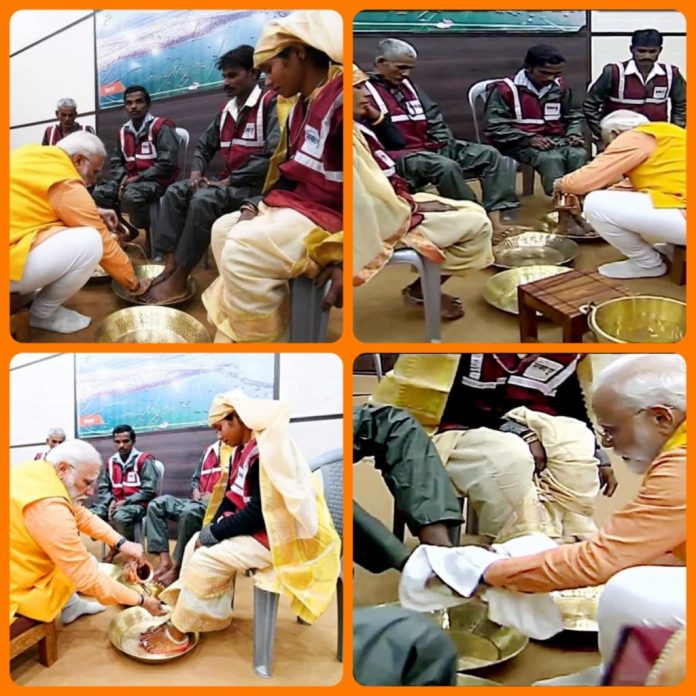By Ram Puniyani
Gimmicks are a part of Modi’s style of politics. Rather they form the core of his strategies. His act of washing the feet of five sanitary workers and then tweeting it, came as another such act. Irritated by this, many a social activist responded through tweets. Bezwada Wilson, convener of Safai Kamgar Sangthan, our fighter against manual scavenging, tweeted “105 people killed in sewer and septic tanks in 2018 alone. He kept mum. Now washing feet. Justice not rituals, Mr. PM! What a pity!’
“As a CM, he spiritualized shit cleaning, now as PM glorifying injustice…. this act is against Baba Saheb Ambedkar’s mission – jhaadoo chhodo kalam pakdo(leave the broom, pick up the pen) #StopKillingUs.” And further: “Clean your mind not our feet, Mr. PM! Highest form of humiliation. 1.6 lac women still forced to clean shit, not a single word in five years. What a shame!” he continued in his tweet.
This, in a way summed up the pain and anguish of the victims of caste system in this brutal form. Sitaram Yechuri points out that despite the death of 105 workers in sewers and septic tanks in 2018 & 11 in 2019 alone, nothing has been done to redress the grave situation despite Court Orders. He said that “photo shoots with multiple cameras only rub salt into the wounds of those suffering historical injustices,” Similarly CPI(ML) liberation draws our attention to another aspect of the problem, “PMO India, it’s your job to ensure sanitation workers are paid dues, end manual scavenging & sewer deaths. Instead you are striking poses washing their feet! A sanitation worker died in #KumbhMela2019 due to negligence, will you speak on that?”
As such, while washing the feet of these workers, a sort of glorification of the system is being done. The people who work as sanitation workers in India are not heroes but victims. Another set of data tells us that 2014 to 2016, at least 1,327 sanitation workers died across India as they were sent into sewers without any safety equipment. Death alone is not true reflective of this ignominy. Manually cleaning excreta is a terribly degrading and humiliating work. It strips away a person’s humanity. The very existence of hereditary castes of sanitation workers is a dark blot on India. Even countries poorer than India have abolished this horrid practice.
The reason it persists in India for so long can best be understood from the values and mindset of people like Modi and his parent organization, the RSS. Modi in his book Karmyoga (2007) states, “Scavenging must have been a spiritual experience for the Valmiki caste. At some point of time, somebody must have got the enlightenment that it is their [Valmikis’] duty to work for the happiness of the entire society and the gods; that they have to do this job bestowed upon them by the gods; and that this job of cleaning-up should continue as an internal spiritual activity for centuries. This should have continued generation after generation. It is impossible to believe that their ancestors did not have the choice of adopting any other work or business.”
This spiritual experience is reserved for the Valmikis, a sub-caste among Dalits, which has been condemned to scavenging jobs for centuries. The functions of the caste are being glorified and propagated even today in subtle ways.

The deeper goal of RSS, Modi’s parent organization is to maintain the status quo as far as caste system is concerned. One of the major reasons for formation of RSS was the rising assertion of Dalits, inspired by Joti Rao Phule and Bhimrao Ambedkar. Dalits had started non Brahman movement in 1920s in Vidarbha region. This upsurge among Dalits disturbed the upper caste; who rallied around to form RSS in 1925. RSS leader Golwalkar regards Manusmriti as a glorious book that gave laws to the Hindu society. Ambedkar on other side burnt the same book as a symbol of caste oppression and gender hierarchy.
Manual scavenging in its present form should have been abolished long ago. This practice was officially supposed to have been banned in 1993 by the Government of India. Official lapses and apathy apart, the surveys by the activists working against this practice show that even now lakhs of scavengers are still facing ignominy and nearly 95% of these workers are women. These scavengers are the untouchable section of dalits, who have been trapped in this occupation. The States have not taken any action to abolosh this practise. Even in 1999-2000 many a State did not not even think of this as somethng that needs to go. It is in this light that the social action group Safai Karmachari Andolan which is campaigning against manual scavenging gave a call for abolition of this atrocity by the end of 2010.
The system of manual scavenging began in early India, well justified by caste system and continued in medieval times as well. While the Muslim kings did introduce different techniques at places, for water based disposal of excreta. But those playing communal politics, try to propagate that since the Muslim women wore Burqua, they could not go out to the jungles, they introduced manual scavenging. This is another way of putting the blame of internal problems to external sources. This is far from true. Observation and research into the Mughal forts’ sanitation system shows that they had small outlets in the bathing rooms of Mughal forts which were used as toilets. The waste from these toilets was carried by gravitational force to the ramparts with the help of water. This technique has been seen in the Red Fort in Delhi, in the palaces of Rajasthan, in Hampi, Karnataka and in Thiruvananthapuram, Kerala.
We should collectively strive towards abolishing manual scavenging and restore the dignity of those who are forced into this slavery.

